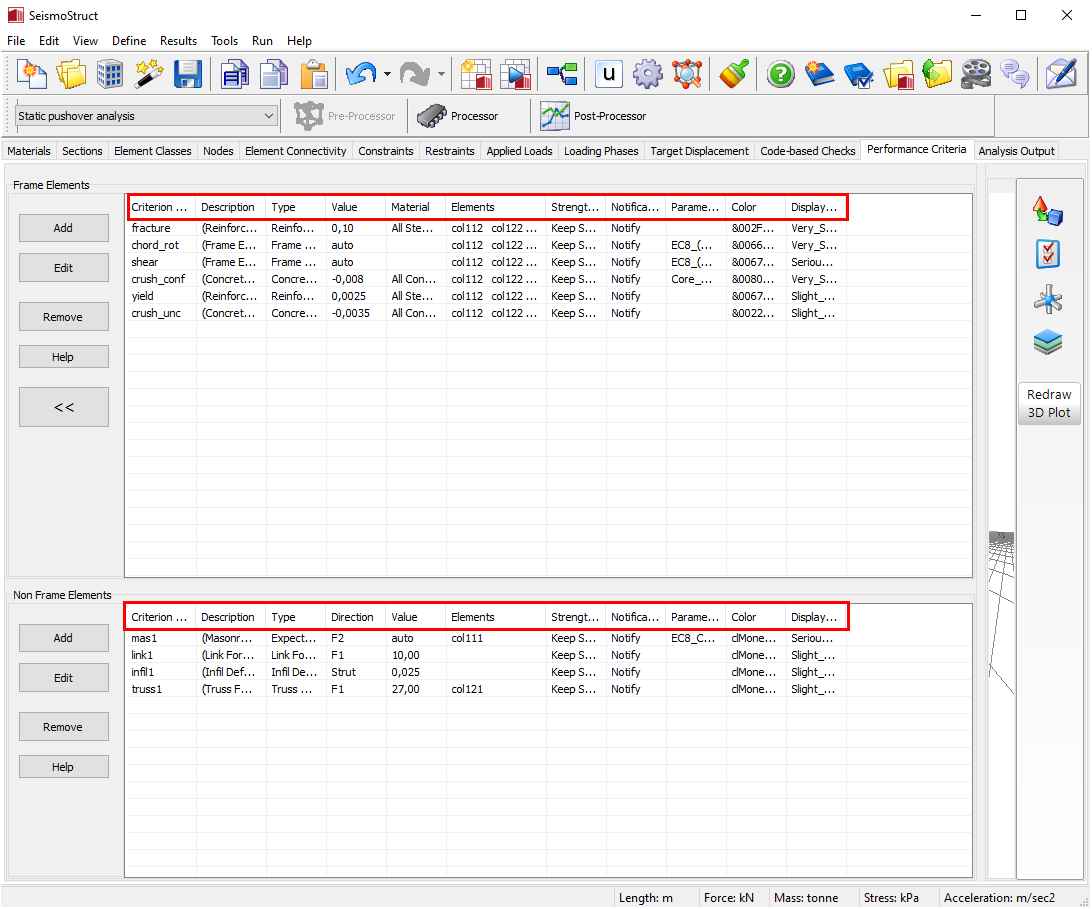Performance Criteria
Within the context of performance-based engineering, it is paramount that analysts and engineers are capable of identifying the instants at which different performance limit states (e.g. non-structural damage, structural damage, collapse) are reached. This can be efficiently carried out in SeismoStruct through the definition of performance criteria, whereby the attainment of a given threshold value of material strain, section curvature, element chord-rotation and/or element shear, element force/moment, element deformation, element drift, etc. during the analysis of a structure is automatically monitored by the program. Different areas for Frame Elements and Non Frame Elements performance criteria definition are available.

The type of criteria to be used does clearly depend on the objectives of the user. However, within the context of a fibre-based modelling approach, such as that implemented in SeismoStruct, material strains do usually constitute the best parameter for identification of the performance state of a given structure:
- Cracking of structural elements can be detected by checking for (positive) concrete strains larger than the ratio between the tension strength and the initial stiffness of the concrete material. [typical value: +0.0001]
- Spalling of cover concrete can be recognised by checking for (negative) cover concrete strains larger than the ultimate crushing strain of unconfined concrete material. [typical value: -0.002]
- Crushing of core concrete can be verified by selecting the “Check the Core Only” check-box and checking for (negative) core concrete strains larger than the ultimate crushing strain of confined concrete material. [typical value: -0.006]
- Yielding of steel can be identified by checking for (positive) steel strains larger than the ratio between yield strength and modulus of elasticity of the steel material. [typical value: + 0.0025]
- Fracture of steel can be established by checking for (positive) steel strains larger than the fracture strain. [typical value: +0.060]

Alternatively, or in addition, section curvatures and/or chord-rotations can readily be employed in the verification of a myriad of performance limit states, in which case users should refer to available literature for guidance on curvature/rotation values to be employed [e.g. Priestley, 2003]. Further, it is also feasible to monitor the shear values of frame elements, with the definition of one or more shear threshold values.
Finally, chord rotation yielding, chord rotation capacity and element shear capacity checks for frame elements can be introduced, whereby the program automatically calculates the capacity of the elements during the analysis, according to the selected equations , and checks it against the corresponding demand. Elements’ Force/moment, displacement and Drift checks for non frame elements can be introduced, whereby the program automatically calculates the capacity of the elements during the analysis, according to the selected equation of the available Codes (Eurocodes, ASCE 41-23 and NTC-18), and checks it against the corresponding demand or user-defined values. It is noted that expected values will be calculated, considering mean material strengths and no safety of confidence factors.
In order to introduce a given structural performance check, users need to define the criterion's name/identifier, its type (i.e. the response quantity to be controlled; material strain, section curvature, element chord-rotation, element shear, element chord rotation capacity or element shear capacity for frame elements and element force/moment, deformation, drift, shear force, compressive force and bending moment for non frame elements depending on the element type), the value at which the performance criterion is reached, the equation according to which the Automatically-defined limit will be computed, the inelastic frame elements to which the criterion applies to, the strength degradation of the element, when the performance criterion has been achieved (users can specify the residual strength as a percentage of capacity, or select to remove the element completely, or to keep it without strength degradation) and the type of action upon the attainment of each criterion; (i) stop the analysis and introduce a notification in the analysis log, (ii) pause the analysis and introduce a notification in the analysis log, (iii) leave the analysis undisturbed and introduce a notification in the analysis log, (iv) ignore the occurrence, that is, render the criterion inactive. A colour may also be assigned to each given criterion defined by the user, as well as a type of damage visual effects,to enable graphical visualisation in the Deformed Shape Viewer module.
Important: It is noted that users should be very careful with the selection in strength degradation, because it might lead to numerical instabilities.
Notes
- In the Performance Criteria where only positive values are allowed, the checks are carried out against the absolute value of the response quantity for the demand. Whereas, in the Performance Criteria where both positive and negative values are defined, the check is carried out against the signed value of the response quantity, and different values for the positive and negative values are allowed. In the latter case, if users introduce a positive criterion value, the program will automatically consider a "larger than" performance check. Conversely, if a negative criterion value is defined, the program will automatically activate a "smaller than" performance check.
- Strain and curvature performance checks are carried out at the Integration Sections of the selected elements.
- Note that Performance Criteria can only be set to control the response of inelastic frame elements. The latter, however, may always be defined with an elastic material, which effectively means that performance criteria can also be applied to members whose response is elastic.
- Introduction of Performance Criteria checks during the analysis does induce a slight increase in its running time, for obvious reasons.
- The mean material values without safety or confidence factors are used in the case of criteria where the capacity is automatically calculated by the program, i.e. chord rotation yielding, chord rotation capacity and shear capacity.